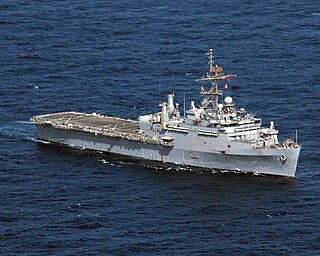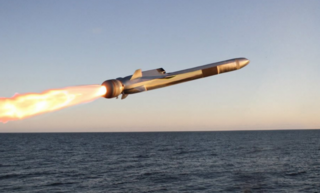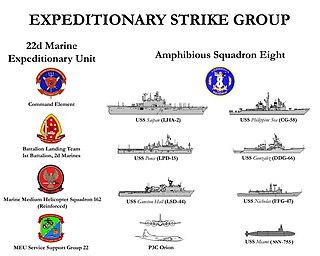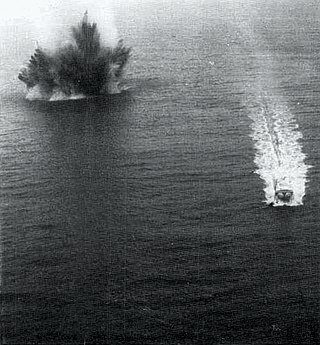
The San Antonio class is a class of amphibious transport docks, also called a "landing platform, dock" (LPD), used by the United States Navy. These warships replace the Austin-class LPDs, as well as the Newport-class tank landing ships, the Anchorage-class dock landing ships, and the Charleston-class amphibious cargo ships that have already been retired.

USS Cleveland (LPD-7), an Austin-class amphibious transport dock, was the third ship of the United States Navy to be named for the city in Ohio. Her keel was laid down at Ingalls Shipbuilding of Pascagoula, Mississippi. She was launched on 7 May 1966, and was commissioned on 21 April 1967 at Norfolk, Virginia. At the time of decommissioning, she was the third-oldest commissioned ship in the US Navy, behind USS Constitution and USS Enterprise.

USS New Orleans (LPD-18), a San Antonio-class amphibious transport dock, is the fourth commissioned ship of the United States Navy to be named after the city of New Orleans, Louisiana.

USS Shreveport (LPD-12) was an Austin-class amphibious transport dock. It was the second ship of the United States Navy to be named for the city in Louisiana. Her keel was laid down on 27 December 1965 by the Lockheed Shipbuilding and Construction Company of Seattle, Washington. She was launched on 22 October 1966 sponsored by Mrs. Andrew McBurney Jackson, Jr., and commissioned on 12 December 1970.

USS Nashville (LPD-13), was an Austin-class amphibious transport dock and the third ship of the United States Navy to be named for the capital city of Tennessee. Her keel was laid down on 14 March 1966 by the Lockheed Shipbuilding and Construction Company of Seattle, Washington. She was launched on 7 October 1967 sponsored by Mrs. Roy L. Johnson, and commissioned at Puget Sound Naval Shipyard, Bremerton, Washington, on 14 February 1970.

USS New Orleans (LPH-11) was an Iwo Jima-class amphibious assault ship in the United States Navy. She was the third Navy ship to be so named, and is the first named for the Battle of New Orleans, which was the last major battle of the War of 1812.

USS Denver (LPD-9), an Austin-class amphibious transport dock, was the third ship of United States Navy to bear this name. Denver's keel was laid on 7 July 1964 at Lockheed Shipbuilding and Construction Company, Seattle, Washington. She was launched on 23 January 1965, christened by Mrs. Ann Daniels Love, wife of John A. Love, the former governor of Colorado, and commissioned on 26 October 1968. After 46 years of service, Denver was decommissioned at Joint Base Pearl Harbor–Hickam on 14 August 2014. At the time of her decommissioning, Denver was the oldest deployable warship in the U.S. Navy, and was one of the last active warships to have served in Vietnam.
The Rim of the Pacific Exercise (RIMPAC) is the world's largest international maritime warfare exercise. RIMPAC is held biennially during June and July of even-numbered years from Honolulu, Hawaii, with the exception of 2020 where it was held in August. It is hosted and administered by the United States Navy's Indo-Pacific Command, headquartered at Pearl Harbor, in conjunction with the Marine Corps, the Coast Guard, and Hawaii National Guard forces under the control of the Governor of Hawaii.

USS Curts (FFG-38) was the twenty-ninth ship of the Oliver Hazard Perry-class of guided-missile frigates. She was named for Admiral Maurice Curts (1898–1976). Curts is the first ship of that name in the US Navy.

Command ships serve as the flagships of the commander of a fleet. They provide communications, office space, and accommodations for a fleet commander and their staff, and serve to coordinate fleet activities.

HNoMS Fridtjof Nansen is a frigate of the Royal Norwegian Navy. Launched on 5 April 2006, she is the lead ship of the Fridtjof Nansen class of warships.

USS Arlington (LPD-24), a San Antonio-class amphibious transport dock, is the third ship of the United States Navy to be named for Arlington County, Virginia, the location of the Pentagon and the crash site of American Airlines Flight 77 during the terrorist attacks on 11 September 2001. Like her sister ships, USS New York and Somerset, she is named in commemoration of the attacks. Steel taken from the Pentagon after the attacks is displayed aboard in the ship's museum.

Operation United Shield was the codename of a military operation, conducted 9 January to 3 March 1995, bringing a conclusion to the United Nations Operation in Somalia II. Commanded by the United States, two ships of the Pakistan Navy, five ships of the Italian Navy and six ships of the United States Navy formed a Combined Task Force (CTF) ensuring the safe evacuation of all UN Peacekeeping Forces from Somalia.

The Naval Strike Missile (NSM) is an anti-ship and land-attack missile developed by the Norwegian company Kongsberg Defence & Aerospace (KDA).

USS Durham (LKA-114) was a Charleston-class amphibious cargo ship in service with the United States Navy from 1969 to 1994. She was sunk as a target in August 2020.

In the United States Navy, the expeditionary strike group (ESG) is a coordinated group of surface ships, aircraft, submarines, and other naval assets. In contrast to carrier strike groups (CSGs), which emphasize air power and are led by a supercarrier, ESGs are strongly suited for amphibious warfare and are led by an amphibious assault ship. The ESG concept was introduced in the early 1990s, based on the Naval Expeditionary Task Force. The U.S. Navy fields nine expeditionary strike groups.

USS Mount Vernon (LSD-39) was an Anchorage-class dock landing ship of the United States Navy. She was the fifth ship of the U.S. Navy to bear the name. She was built in Massachusetts in 1972 and homeported in Southern California for 31 years until being decommissioned on 25 July 2003. Mount Vernon acted as the control ship for the cleanup of the Exxon Valdez oil spill. In 2005, she was intentionally destroyed off the coast of Hawaii as part of a training exercise. USS Mount Vernon also appeared in the Season 7 episode 19 of The Love Boat when they visited Hong Kong.

Operation End Sweep was a United States Navy and United States Marine Corps operation to remove naval mines from Haiphong harbor and other coastal and inland waterways in North Vietnam between February and July 1973. The operation fulfilled an American obligation under the Paris Peace Accord of January 1973, which ended direct American participation in the Vietnam War. It also was the first operational deployment of a U.S. Navy air mine countermeasures capability.

USNS Navajo (T-ATF-169) was a United States Navy Powhatan-class tugboat operated by the Military Sealift Command which was in service from 1980 to 2016. She spent the bulk of her career in the Pacific and is currently moored in Pearl Harbor, awaiting disposal.

USS Portland (LPD-27) is a San Antonio-class amphibious transport dock ship of the United States Navy, named after the U.S. city of Portland, Oregon.






















